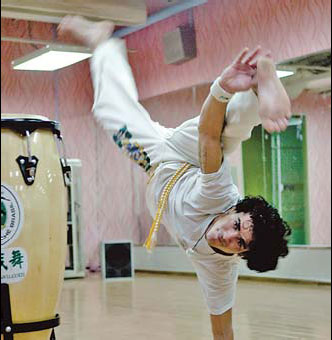Society
Musical martial arts classes from Brazil catch on
By Cao Huan (China Daily)
Updated: 2010-10-06 09:33
 |
Large Medium Small |
Martial arts are nothing new in China, but Brazil's capoeira (ca-po-ei-ra) is a recent introduction. The sport blends music, singing and dance to create an innovative form of self-defense.
Andre Cao, a former fitness instructor in charge of a capoeira program in Beijing, learned capoeira in Canada. Last year, he brought some practitioners to the capital, where they staged a show in Sanlitun.
"It was amazing. After the show, many people inquired about the sport and asked whether we had classes in China. That gave me the idea of starting the program," Cao says.
Capoeira has a rich history of about 500 years. Cao says African slaves invented it in Brazil during the colonial period. In order to rise up against their masters, they secretly developed a form of combat, adding singing and dancing to disguise it from their masters while they practiced. Eventually it became the national sport of Brazil.
There are two styles: capoeira Angola and capoeira regional.
The former, a traditional style of capoeira, is performed with slow and smooth motions, close to the ground.
Capoeira regional has more acrobatic moves and is faster and more aggressive. It is often seen during performances because the jumping and spinning are eye-catching.
Cao says many people appreciate capoeira for its beauty, but are intimidated because it looks difficult. People don't have to excel at the sport to benefit, Cao says.
"With practice, anyone can get there eventually," he says. Cao taught his 55-year-old mother for two weeks, after which she could do a side flip.
As a martial art, capoeira uses a ranking system that is expressed by the belts that are worn. The rankings are based on the colors of the Brazilian flag. The beginning level is student, followed by graduate, formed, then professor, and the top level is master.
"Ranking is not only based on the performance of that day. Each student's work in the classes and the efforts they make to overcome personal challenges are all taken into account," he says.
Capoeira is beginning to catch on in China. When he first started the program, Cao had six students, most of whom were his friends. Now there are 35 students. They have only one Brazilian teacher at the moment, but are looking to add another by the end of the year.
What really sets capoeira apart from other martial arts is the use of music.
There are five main percussion instruments: berimbau, pandeiro, atabaque, agogo, and reco-reco. Different styles of capoeira use different instruments.
Classes normally end with a circle, in which the instructor plays instruments and students sing and clap.
"Chinese people are shyer in class compared to people from other countries, especially for the first few classes. I try my best to get them involved," says the Brazilian coach named Tamandua.
He adds that it's helpful for students to have a basic understanding of the Portuguese language, like counting numbers from one to 10, which is often used in the singing.
"Capoeira is a fun workout, no matter how fit or unfit you are. It improves strength, flexibility and stamina," he says.
Yang Jiale was one of the first students to begin training late last year. Besides making new friends, Yang says he learned about Brazilian culture and picked up a little Portuguese.
"I learned self-defense skills and at the same time I am having so much fun," Yang says.
Cao has been promoting capoeira by offering free courses at 47 fitness centers in the country.
"Not only does capoeira improve your total well-being, it creates positive energy. I have a great belief that it will do well in China," Cao says.
